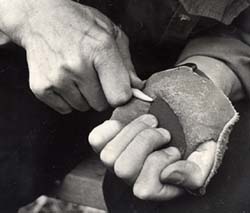How are
points made?
Chert is hard, somewhat brittle, and it has a conchoidal (shell-like)
fracture pattern. When one strikes this type of stone at the proper
angle and with adequate force, it is possible to remove a shell-shaped
flake. By repeatedly removing flakes, one can shape the piece to create
a desired form. Thus, chert breaks in a predictable way; it is brittle
enough to be readily shaped when struck with sufficient force; and it
is hard enough to make durable tool.
A flint (or chert) "knapper" (to strike smartly) is a person who shapes
chert, and other silica-rich stones, by striking them with a hammerstone
or bone baton in precisely the right place, at the right angle, and
with the right force. This technique, called percussion flaking, is
used by a flintknapper to shape a rough block of stone into an oval
or triangular object of desired dimensions, depending on whether he
wants to make a spear, dart, or arrow point. The stem of the point,
that portion of the object that is fastened to a wooden shaft, may be
notched and the edges of the point sharpened by using pressure to remove
small flakes of stone.

|
|
Rob
Bonnichsen using a bone tool to pressure flake a point.
|
This second technique, called pressure flaking, uses a pointed bone
tool that is pressed against the projectile point to remove unwanted
stone. Sometimes, the flintknapper also grinds the edge of the piece
at the spot they intend to remove a flake.
Native
American flintknappers use percussion and pressure flaking techniques
and grinding to render a rough rock into an aerodynamic missile.

